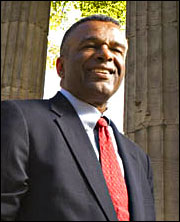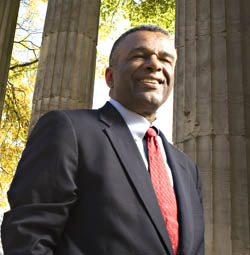
Ron Sims wants to bring a fresh, green perspective to the Department of Housing and Urban Development. Sims — the county executive of King County, Wash., which encompasses the Seattle metropolitan area — is President Obama’s nominee for deputy secretary of the department.
“President Obama has … challenged his Cabinet to prepare for the age of global warming,” Sims said in a statement shortly after he was nominated. “Success can only come if we transform our major metropolitan areas.”
Urbanists are hoping for big, green things from HUD under Obama and Secretary Shaun Donovan. The addition of Sims is seen as another good sign, as his environmental work in Washington state has earned him national attention over the past 12 years.
HUD will be making a big push to curb greenhouse-gas emissions in major urban hubs, Sims told Grist recently.
“The idea is to be able to move pretty boldly and get back to a mission of improving the quality of life in every metropolitan area of the country,” Sims said. “So I’m going to be doing that, and doing that in a way that is sustainable, and doing it in a way that meets the targets that are clearly being enunciated by [White House energy adviser Carol] Browner and the president for the reduction of our carbon emissions.”
The Senate is expected to hold a confirmation hearing on Sims within the next few weeks. In the meantime, he’s reflecting on his work over the years in King County, home to 1.8 million residents.
Sims has built up a national reputation for his efforts to reduce carbon emissions in the Seattle area and prepare the region for some of the now-unavoidable impacts of climate change. His work on global warming helped earn him acknowledgement as a Public Official of the Year in 2006 from Governing magazine, which honored him again in 2008 as one of America’s Innovative Leaders for his work on mass transit.
King County’s plan to reduce greenhouse-gas emissions was enacted in 2007, and it’s already seeing results. According to its most recent climate report, in 2007 the county reduced emissions from its operations by more than 6 percent below 2000 levels, as measured by the Chicago Climate Exchange, a voluntary cap-and-trade market. It was the first county to join the exchange, and King County Metro Transit was the first major bus transit agency to join.
To lower emissions, the county has improved the energy efficiency of government buildings, added 22 new hybrid buses to the transit system, increased use of biofuel in buses, and switched to more fuel-efficient trucks, cutting consumption of diesel fuel by 145,000 gallons.
But Sims cites the county’s work on a climate-change adaptation plan as the most groundbreaking. The plan — which calls for repairing levees and preparing for floods as water levels rise and ice packs melt — faced a lot of initial criticism from those who didn’t see the need for government spending on something that wasn’t yet a problem. “There weren’t a lot of people sympathetic to that,” Sims told Grist. “We were pointing out no, it’s the real world, don’t ignore it. It’s going to occur, scientists have been saying it’s going to occur, so we embraced the science.”
Sims said climate adaptation will be an important part of his work at HUD, helping low-income communities that are likely to be hit hardest by climate change. “When we’re rebuilding the country, in those neighborhoods let’s do that in the context of what we know is occurring in the age of global warming,” said Sims, noting the potential for green roofs and new paving techniques to cut down on the heat-island effect, which makes cities warmer than surrounding areas. “Adaptation and the issue of addressing poorer communities are often ignored and under-discussed in our dialogue on global warming.”
In his new post, Sims will apply lessons learned from his work in the Seattle area, but also take inspiration from cities like Chicago, Denver, Los Angeles, New York, Phoenix, and San Francisco, where mayors have launched innovative programs to curb emissions. “My job is to find those areas where folks are doing that and say, folks, let’s meet, let’s begin to work with Secretary Donavan on a strategy that basically says we’re not having to start from scratch,” said Sims.
Sims will also be collaborating with other agencies of the federal government as they work to tackle global warming, particularly in urban areas. He’ll be heading up a new, as-yet-unnamed office within HUD that will coordinate with White House energy adviser Carol Browner, the new White House Office of Urban Policy, and departments like transportation, energy, and labor. “The office helps break down the silos,” said Sims.
At its core, Sims believes his work is about preparing for the future and putting in place policies to ensure the best possible outcomes. “I’ve always said the question that everybody should ask is, ‘What will happen in 2050?,’ and work backwards,” he said.


